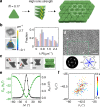Hierarchical self-assembly of 3D lattices from polydisperse anisometric colloids
- PMID: 31000717
- PMCID: PMC6472373
- DOI: 10.1038/s41467-019-09787-6
Hierarchical self-assembly of 3D lattices from polydisperse anisometric colloids
Abstract
Colloids are mainly divided into two types defined by size. Micron-scale colloids are widely used as model systems to study phase transitions, while nanoparticles have physicochemical properties unique to their size. Here we study a promising yet underexplored third type: anisometric colloids, which integrate micrometer and nanometer dimensions into the same particle. We show that our prototypical system of anisometric silver plates with a high polydispersity assemble, unexpectedly, into an ordered, three-dimensional lattice. Real-time imaging and interaction modeling elucidate the crucial role of anisometry, which directs hierarchical assembly into secondary building blocks-columns-which are sufficiently monodisperse for further ordering. Ionic strength and plate tip morphology control the shape of the columns, and therefore the final lattice structures (hexagonal versus honeycomb). Our joint experiment-modeling study demonstrates potentials of encoding unconventional assembly in anisometric colloids, which can likely introduce properties and phase behaviors inaccessible to micron- or nanometer-scale colloids.
Conflict of interest statement
The authors declare no competing interests.
Figures




Similar articles
-
Hierarchical self-assembly of polydisperse colloidal bananas into a two-dimensional vortex phase.Proc Natl Acad Sci U S A. 2021 Aug 17;118(33):e2107241118. doi: 10.1073/pnas.2107241118. Proc Natl Acad Sci U S A. 2021. PMID: 34389681 Free PMC article.
-
Polymerization-Like Co-Assembly of Silver Nanoplates and Patchy Spheres.ACS Nano. 2017 Aug 22;11(8):7626-7633. doi: 10.1021/acsnano.7b02059. Epub 2017 Jul 28. ACS Nano. 2017. PMID: 28715193
-
Self-assembly and reconfigurability of shape-shifting particles.ACS Nano. 2011 Nov 22;5(11):8892-903. doi: 10.1021/nn203067y. Epub 2011 Oct 10. ACS Nano. 2011. PMID: 21950837
-
Molecular Recognition in the Colloidal World.Acc Chem Res. 2017 Nov 21;50(11):2756-2766. doi: 10.1021/acs.accounts.7b00370. Epub 2017 Oct 6. Acc Chem Res. 2017. PMID: 28984441 Review.
-
Self-Assembly in an Experimentally Realistic Model of Lobed Patchy Colloids.ACS Appl Bio Mater. 2024 Feb 19;7(2):535-542. doi: 10.1021/acsabm.2c00910. Epub 2023 Jan 25. ACS Appl Bio Mater. 2024. PMID: 36698242 Free PMC article. Review.
Cited by
-
Low-dimensional assemblies of metal-organic framework particles and mutually coordinated anisotropy.Nat Commun. 2022 Jul 9;13(1):3980. doi: 10.1038/s41467-022-31651-3. Nat Commun. 2022. PMID: 35810163 Free PMC article.
-
Hierarchical self-assembly of polydisperse colloidal bananas into a two-dimensional vortex phase.Proc Natl Acad Sci U S A. 2021 Aug 17;118(33):e2107241118. doi: 10.1073/pnas.2107241118. Proc Natl Acad Sci U S A. 2021. PMID: 34389681 Free PMC article.
-
Symmetry-breaking in patch formation on triangular gold nanoparticles by asymmetric polymer grafting.Nat Commun. 2022 Nov 9;13(1):6774. doi: 10.1038/s41467-022-34246-0. Nat Commun. 2022. PMID: 36351911 Free PMC article.
-
Supercrystallography-Based Decoding of Structure and Driving Force of Nanocrystal Assembly.Materials (Basel). 2019 Nov 17;12(22):3771. doi: 10.3390/ma12223771. Materials (Basel). 2019. PMID: 31744175 Free PMC article. Review.
References
Publication types
Grants and funding
LinkOut - more resources
Full Text Sources

